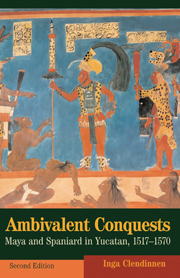Book contents
- Frontmatter
- Contents
- List of illustrations
- Preface to the second edition
- Preface to the first edition
- Acknowledgments
- Map I Yucatan in the conquest period
- Part I Spaniards
- Part II Indians
- Epilogue: Confusion of tongues
- Appendix: A sampler of documents
- Glossary of Spanish and Maya terms
- Notes
- Select bibliography
- Index
Epilogue: Confusion of tongues
Published online by Cambridge University Press: 05 October 2013
- Frontmatter
- Contents
- List of illustrations
- Preface to the second edition
- Preface to the first edition
- Acknowledgments
- Map I Yucatan in the conquest period
- Part I Spaniards
- Part II Indians
- Epilogue: Confusion of tongues
- Appendix: A sampler of documents
- Glossary of Spanish and Maya terms
- Notes
- Select bibliography
- Index
Summary
The events of 1562 probably marked a major shift in Maya evaluation of the status of the Spanish religion. Until that point, the Spanish presence was seen as temporary, and Christian teachings as little more than interesting novelties to be scanned for useful notions. That attitude changed, I think with the trials. In that three-month-long reign of terror the priests of the new religion, until then peripheral or intermittent factors in Indian awareness, came and sat down in the villages. The idols and the jewelled skulls of the ancestors were burned at their command. The violence, the sufferings inflicted by the friars, the destruction of the idols, signalled that the time of the old gods was indeed over, and the rule of the new gods had begun; when ‘the descendants of the former rulers are brought to misery; we are christianised, while they treat us like animals’. The Chumayel characterises 9 Ahau as the katun ‘when Christianity began, when baptism occurred. It was in this katun that Bishop Toral arrived here also. It was when the hangings ceased in the year of Our Lord 1546. And 7 Ahau was when Bishop Landa died …’
- Type
- Chapter
- Information
- Ambivalent ConquestsMaya and Spaniard in Yucatan, 1517–1570, pp. 190 - 194Publisher: Cambridge University PressPrint publication year: 2003

